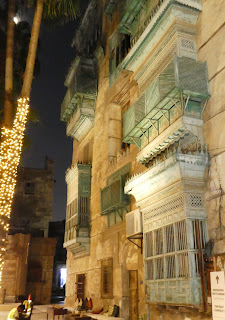After the group tour, I had opted to stay on in Saudi Arabia for a few more days, with a friend, so see a few sites in the Asir Mountains region. I wish I had added more time so as to relax a little in Jeddah where the group made only a fleeting visit, but we had to make the most of the days we had, so we took a taxi to the hire car office that the hotel told us was open. One of the most frustrating things about Saudi was that places (offices, restaurants, museums ...) were closed, for no obvious reason, for much of the time, and this was no exception. But once again the Saudi hospitality (or curiosity about foreigners?) was forthcoming, and a man who saw us looking despairingly into the closed windows of the office offered to help, and drove us for twenty minutes to another car hire office which he knew would be open.
So finally we set out for the south, the first day being just a LONG drive along the (almost) coast road - flat and fairly featureless, with just one or two camels to keep me amused. But on the second day we turned into the mountain area. Where the first surprise was the sight of baboons! There were hundreds of them, swarming around rubbish bins and hanging around any lookout stops along the road, where they scavenged for food. Not very friendly (one irritated male ran over and smacked my foot when I did something that annoyed him), but quite photogenic!The mountains were fairly bare and rocky, and dotted with old watch-towers and other buildings constructed from the local dark stone with white quartz decoration above the windows and sometimes along the roof line. It was sad to see so many of them crumbling, but there is a national programme that has allocated money for preservation of the heritage, and the village of Rijal Alma is one of the best.
We also stopped to explore a few of the abandoned buildings along the route, including these below where you can also see the other building style - layers of mud separated by rows of slate to protect the building from rain - more usually found in the valleys. The roofs had mostly collapsed, and none of those we were able to see into had any of the traditional brightly-painted wall coverings remaining.
Not changing so much that we were tempted into Mecca, though. We accidentally followed one of the Muslims Only lanes as we approached the city, and so drove through on the inner rather than outer ringroad, but we did not take any of the turnings to Al-Masjid al Haram, with their pictures of the kaaba on the signs. Apparently some independent travellers have been right into the city, and up to the outside of the mosque, but as far as we know it is technically still forbidden, and the rewards to me don't seem to outweigh either the risks nor the lack of respect to our host country that such a visit would have involved. We could in any case clearly see the enormous Abraj Al-Bait clock tower (currently the fourth tallest building in the world).
Unfortunately no time at the end of the trip to see more of Jeddah, just time to return the car, get something to eat, and start the long flight home.















